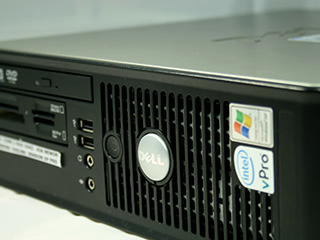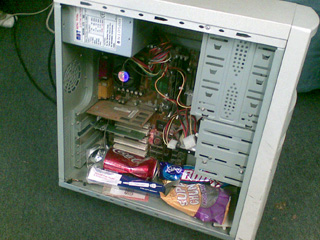From time to time we get stock of ex-leased, refurbished or second hand PCs for sale. These machines are purchased in bulk from auctions and insolvency sales. They are typically offered with 30 day warranties by our upstream suppliers – to protect against any DOA or imminent-failure issues.

These machines are usually sourced originally from banks or other large companies, government departments and councils. These organisations generally renew their desktop machines after three years.
Used and particularly ex-lease machines are priced at a very substantial discount to new machines. The hardware specifications compared with price are chosen to represent very good savings for the machines’ relative computing power. In addition, used machines will normally come with full licenses to Professional editions of Windows (Windows XP Professional, Windows 7 Professional). Experience has shown that the replacement cost of these software licenses is often equivalent to the price of the second-hand machine.
While these machines sell out very quickly and are often purchased on impulse, there are some considerations we recommend customers take into account before laying down a couple of hundred dollars for one. These considerations go beyond just the price.
To some extent these guidelines can be applied to clearance items at retailers as well. It is not uncommon to have machines one or even two years old on offer at end of year sales.
When we design a new PC at Digital Guru, we generally design to a working lifespan of five years. We advise that the customer can expect around five good years of usage taking into consideration advances in software requirements as well as reasonable upgrades to memory and storage during that life span.
We have found over the years that many customers will keep our machines much longer than five years of course, though the upgradeability can diminish after this five year period with new memory and bus technologies being released every couple of years. The cost effectiveness of upgrades will become more of an issue after five to eight years.
Before considering a used PC, get familiar with some of the current main technologies used within the machine. These will affect the upgradeability, repairability and cost thereof of the used machine you purchase. Items to look out for specifically are:
- The disk interface – IDE is outdated and difficult to replace, as of this writing SATA3 is the norm, though most SATA 1, 2 or 3 controller interfaces will be compatible with SATA 1,2 or 3 disks (with the limiting factor being the speed of the lowest level interface);
- The graphics interface – AGP video cards are becoming more scarce, PCI Express is the current standard;
- Memory – DDR3 is the memory interface used in new PCs currently – both DDR and DDR2 replacement modules are increasing in price with age as supply tapers off;
When purchasing a second-hand PC the working life expectancy will obviously be less than a new PC. Though this will also be dependant on the task expected of it. Aside from the bus and interface technologies mentioned briefly above, three predominant factors come into account here – the CPU generation or “brand” (eg, Pentium 4, Core 2 Duo/Quad), the power supply; and the age of the hard disk.
The CPU generation can be a little hard to determine when buying a second hand PC. A good starting point for researching CPU chronology is the Wikipedia article on Intel’s x86 Architecture. You will see linked from this page are individual articles on different brands such as Pentium 4 and Core 2. Clicking on these articles will allow you to drill down further into sub-models to determine the approximate age of the architecture you are purchasing.
If the PC is to become a NAS or low-demand home server then CPU will obviously be less of a consideration than, say, disk I/O. If you are looking for a high-powered workstation then the CPU choice will be much more critical. Consider also whether the CPU has certain technologies you may require such as Virtualisation Extensions, etc. Research too whether your prospective purchase will meet the recommended hardware requirements of any software you intend to install and run on it.
Another issue to weigh up against a new PC is the age and model of OEM parts such as the internal power supply. The power supply is a common area of failure either due to normal wear and tear, or external events such as power surges.
Purchasing a machine with a standard ATX power supply will not pose as much of a problem if it fails, as a standard ATX replacement is inexpensive and very easy to find. On the other hand, a custom-fit, non-standard size, brand-name power supply will normally require purchase through the manufacturer’s spare parts department. Often it can be more economical to replace the PC than replace a custom power supply from a brand-name manufacturer.
Hard disks normally have varying warranties from between one and five years. This can be taken as a layman’s guide to life expectancy. While hard disks will normally conform to a MTBF value, and outlive this and their waranty period, a warranty will not get your data back in the case of a failure. Hard disks will degrade over time by design. They accumulate errors and are designed to accommodate these up to a point. We obviously advise customers to back up their data regularly, though in practice any failure will be an inconvenience and possibly expensive.
Another unknown when buying a used hard disk is the actual power-on hours experienced by the disk. Software tools are available which will give you an idea of the power-on hours for a hard disk. These values are recorded in a special eeprom or area of most modern hard disks with “S.M.A.R.T.” functionality.

It is worth mentioning here the unknown amount of physical distress the device may have suffered as well (though this is more relevant to laptop drives). Humour aside, if you notice shoe scuff marks on the case, dents or other signs of impact from falls or abuse then it is probably best to keep looking.
When buying a second hand PC we recommend spending a few dollars on a new hard disk if you plan on storing any important data on it. By all means we would normally fit the replaced disk into a low-cost external USB enclosure to give you a backup medium as well; A win-win solution provided the replacement disk is a similar capacity to the replaced disk or the amount of data to be backed up.
Remember also that replacing a SATA1 disk on a SATA1 bus with a SATA3 disk will offer very little performance enhancement over the original disk beyond perhaps caching and other enhancements. A SATA1 bus will always run at a maximum of 150Gbit/s.
Another consideration when weighing up a new PC versus a used PC is the warranty. A new PC will be delivered with a full warranty. This may be either a manufacturer’s warranty on the entire machine, or more commonly a warranty on the individual components on a generic or “grey box” PC. The latter often exceeding the name brands’ warranty on average. A used PC will, as mentioned, come with a basic DOA warranty of around 30 days to protect you from any failures in transit. Extended warranties bundles with new PCs are also very common these days.
It may seem counter-intuitive, but often spare parts for generic PCs are easier to source than those from major manufacturers. In almost all cases they are much less expensive as well. The reason being that name-brand computers are mass-produced in production runs, often from custom parts (with standard functionality – like motherboards). Once the production run is finished, the market supply of those custom parts is finite, thus if the demand remains constant for spares then supply will diminish and cost will rise. The slim-line black case with blue LEDs might look desirable on your retailer’s display shelf and indeed in your living room, though the price you often pay for this is compromises in the design to accommodate all the required components in that organically-shaped box.
This article has outlined some considerations when deciding between a new and used PC. There is no clear answer in favour of new vs old without knowing the exact purpose the machine will serve. Our staff are always available to help you with your decision and we welcome your questions.

Hi Digital Guru,
I’m thinking about purchasing one of these ex-demo models. However, we are located in Far Norther NSW, can you tell me a little about your freight charges?
Hi Andrew, thanks for your question. We can ship via Australia Post or courier, with freight charges on these items normally between $12 and $25.
Thanks for getting back to me so promptly, I will look into it and get back to you ASAP. Can I contact you via email?
BTW, The photo of the PC with the rubbish in it is hilarious.
Hello Digital Guru,
I am after a Desk Top PC for my kids to use. Cost is very important ATM. Would you recommend an ex demo?
Also do you have ex demo monitors?
Thanks for your enquiry Chris.
We do indeed have ex-lease monitors. Recently we have been receiving plenty of Dell 17″ and 19″ LCDs in 4:3 aspect ratio. Contact us directly for up to date pricing. Expect to bay between $90 and $130.